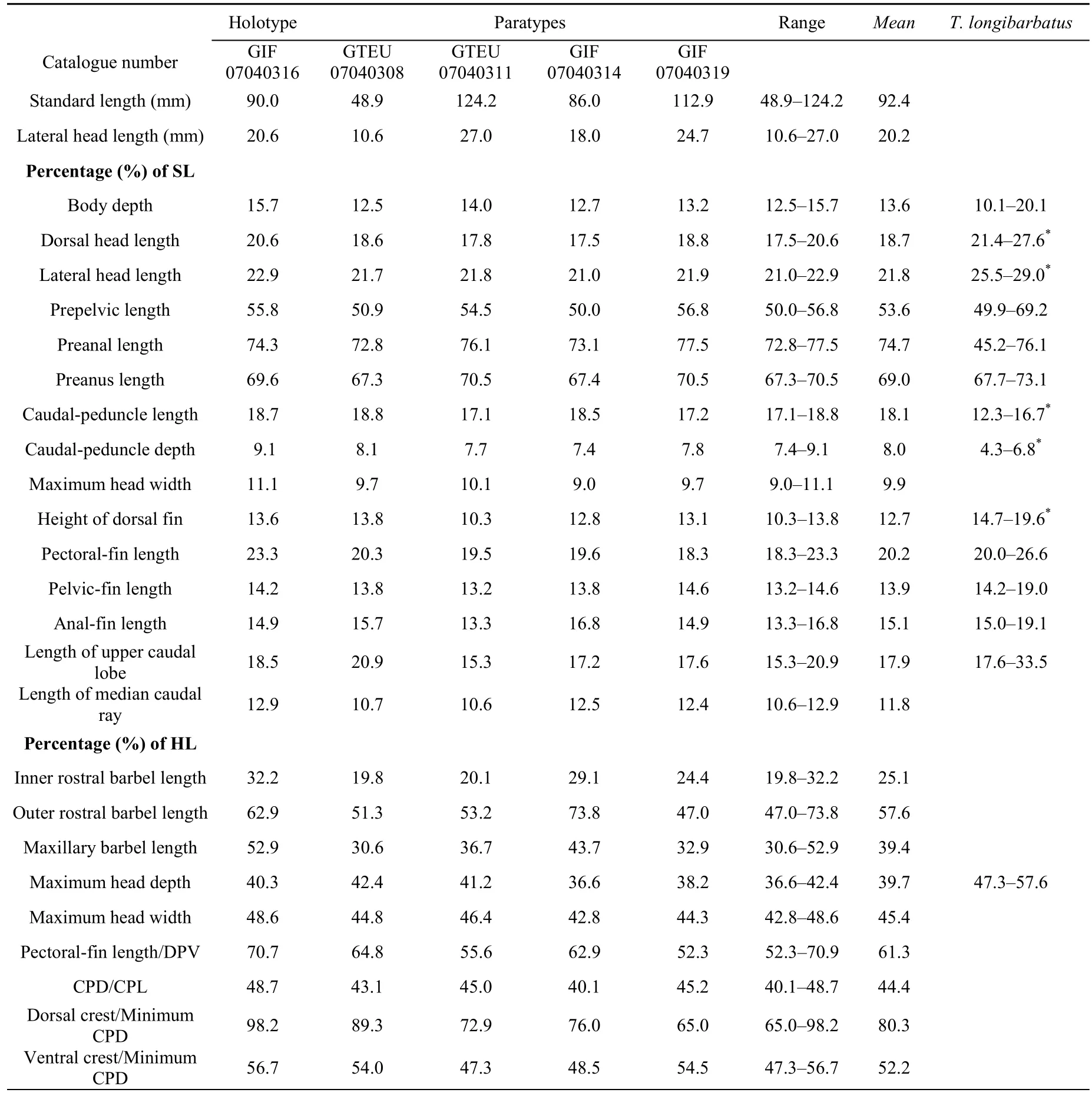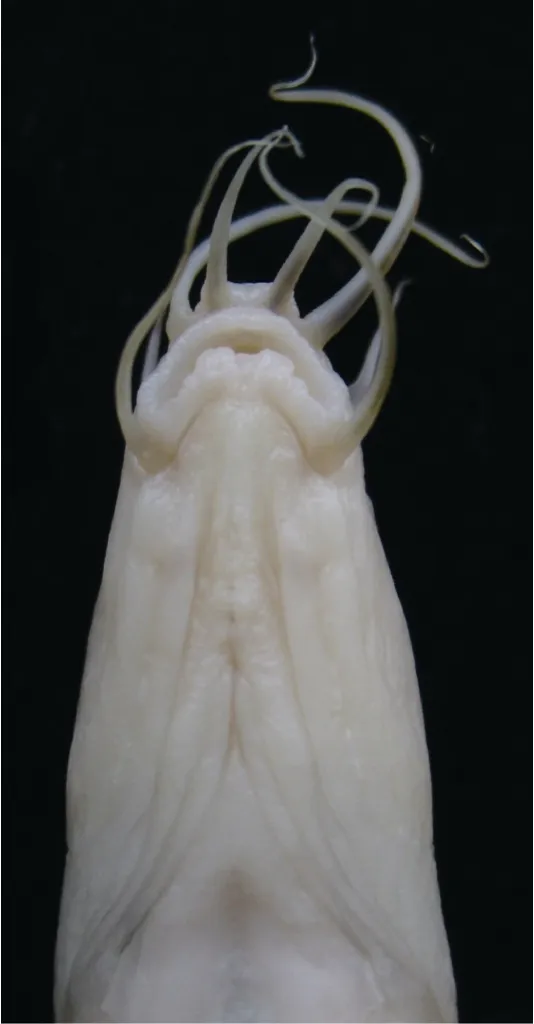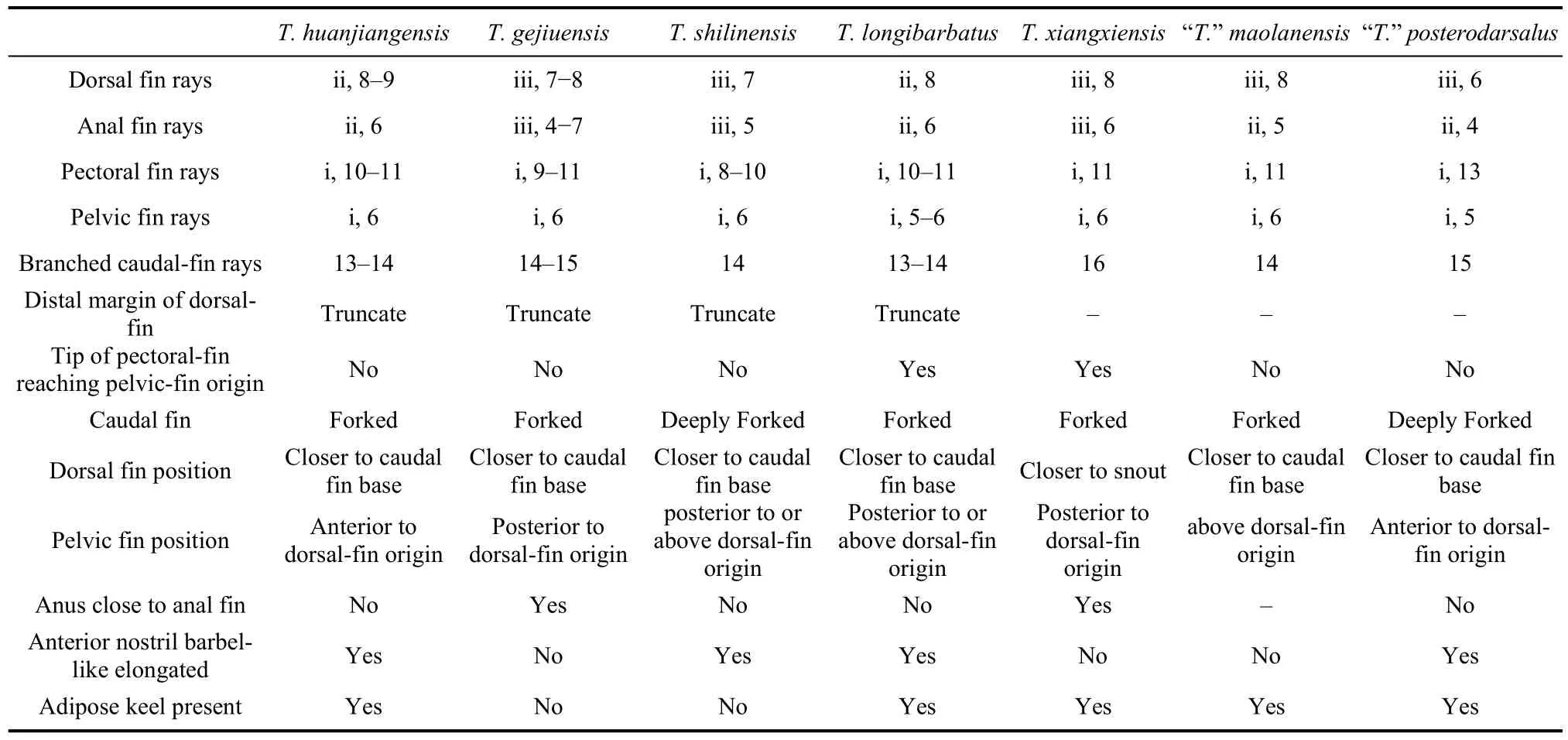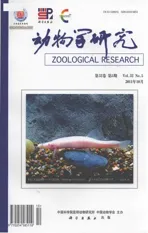A new blind loach species, Triplophysa huanjiangensis (Teleostei: Balitoridae), from Guangxi, China
2011-12-25YANGJianWUTieJunLANJiaHu
YANG Jian, WU Tie-Jun, LAN Jia-Hu
(1. School of Chemistry and Life Sciences, Guangxi Teachers Education University, Nanning 530001, China; 2. Guangxi Institute of Fisheries, Nanning 530021, China; 3. Du’an Fishery Technique Popularization Station, Du’an 530700, China)
A new blind loach species,Triplophysa huanjiangensis(Teleostei: Balitoridae), from Guangxi, China
YANG Jian1,*, WU Tie-Jun2, LAN Jia-Hu3
(1. School of Chemistry and Life Sciences, Guangxi Teachers Education University, Nanning 530001, China; 2. Guangxi Institute of Fisheries, Nanning 530021, China; 3. Du’an Fishery Technique Popularization Station, Du’an 530700, China)
A new blind loach of the genusTriplophysawas collected in 2007 from a cave in Leyi village, located near Chuanshan Town, Huangjiang County in the Guangxi Zhuang Autonomous Region of southern China. The new species,Triplophysa huangjiangensissp. nov, can be distinguished from its congeners by eyes and scales absent; caudalfin forked; adipose keel present; lips with furrows; distal margin of dorsal-fin truncate, dorsal fin origin much closer to caudal-fin base than snout tip; 8–9 branched dorsal-fin rays; 6–7 branched pelvic-fin rays; 6 branched anal-fin rays; 10–11 branched pectoral-fin rays; 13–14 branched caudal-fin rays; pectoral-fin length 52.3%–70.7% the distance between pectoral-fin origin to pelvic-fin origin; dorsal-fin origin posterior to vertical line of pelvic-fin origin; outer rostral barbel longer than other two pairs of barbels, with 47.0%–73.8% of lateral head length; anterior nostril with elongate barbel-like tip; and posterior chamber of gas-bladder developed, reaching pelvic-fin origin.
New species; Blind fish; Balitoridae;Triplophysa; Guangxi
The genusTriplophysaRendahl 1933 is currently placed in the family Balitoridae, subfamily Nemacheilinae (Nelson, 2006).Triplophysacan be distinguished from other nemacheiline genera by possessing close together nostrils, a posterior wall of the bony capsule of the swim bladder, specific sexual dimorphism in which males have tubercle-bearing, elevated skin on both sides of the head, and a thickened tuberculated pad or agglomerations on the dorsal surfaces of the broadened and widened pectoral-fin rays (He et al, 2008; Zheng et al, 2009; Prokofiev, 2010).
Worldwide there are 121 nominal species in theTriplophysagenus, of which, 105 have been recorded in China (Froese & Pauly, 2011; He et al, 2011). Fourteencavefish species from the genusTriplophysahave been recorded in south-west China (Li et al, 2008; Romero et al, 2009; Zheng et al, 2009). Of these, eye vestigial species includeT. rosa(Chen & Yang, 2005),T. tianeensis(Chen et al, 2004),T. aluensis(Li & Zhu, 2000), andT. qiubeiensis(Li et al, 2008), while eye absent species includeT. gejiuensis(Chu & Chen, 1979),T. longibarbatus(Chen et al, 1998),T. shilinensis(Chen et al, 1992), andT. xiangxiensis(Yang et al, 1986). In April 2007, several specimens of a blind loach were collected from a cave in Leyi village, Chuanshan Town, Huanjiang County, Guangxi Zhuang Autonomous Region of southern China. Subsequent examination showed that these specimens should be recognized as a new species belonging to the genusTriplophysa.
1 Materials and Methods
Counts and most measurements followed Kottelat (1990), except for the following: length of median caudal ray was the length of the shortest branched caudal-fin ray; caudal-peduncle depth was measured at the posterior anal-fin base, including the dorsal crest (adipose keel); minimum caudal-peduncle depth excluded the depths of the dorsal and ventral crests; and dorsal and ventral crests were defined as the maximum depth of each crest. Measurements were taken with digital calipers and recorded to 0.1 mm. Abbreviations used in this study include SL for standard length, HL for lateral head length, DPV for distance between pectoral-fin origin to pelvic-fin origin, CPD for caudal-peduncle depth, and CPL for caudal-peduncle length. Data comparing characters for blind and scalelessTriplophysaspecies were obtained from the original descriptions and Chen et al (2004). Materials examined in this study were deposited in the collections of the Guangxi Institute of Fisheries (GIF) and the Guangxi Teachers Education University (GTEU).
2 Results
2.1 Triplophysa huanjiangensis sp. nov. (Fig. 1; Tab. 1)
Holotype: GIF 07040316, 90.0 mm SL, Huanjiang County, Guangxi Zhuang Autonomous Region, China, April 2007, N25°06′2.6″, E108°00′01″; collected by LAN Jiahu.
Paratypes: GIF 07040314, GIF 07040319, GTEU 07040308 and GTEU 07040311, four specimens, 48.9–124.2 mm SL, collected with the holotype.
2.1.1 DiagnosisTriplophysa huanjiangensiscan be distinguished from its congers by the following characteristics: eyes and scales absent; caudal-fin forked; adipose keel present; lips with furrows; distal margin of dorsal-fin truncate, dorsal fin origin much closer to caudal-fin base than snout tip; 8–9 branched dorsal-fin rays; 6–7 branched pelvic-fin rays; 6 branched anal-fin rays; 10–11 branched pectoral-fin rays; 13–14 branched caudal-fin rays; pectoral-fin length 52.3%–70.7% the distance between pectoral-fin origin to pelvic-fin origin; dorsal-fin origin posterior to vertical line of pelvic-fin origin; outer rostral barbel longer than other two barbel pairs, with 47.0%–73.8% of lateral head length; anterior nostril with elongate barbel-like tip; and posterior chamber of gas-bladder developed, reaching pelvic-fin origin.

Fig. 1 Lateral view of Triplophysa huanjiangensis sp. nov. Holotype, GIF 07040316, 90.0 mm SL, Leyi village, Chuanshan Town, Nandan County, Guangxi Zhuang Autonomous Region, China
2.1.2 Description Lateral view ofT. huangjiangensisis provided in Fig. 1. Morphometric data of type specimens ofTriplophysa huanjiangensissp. nov are given in Tab. 1. Dorsal-fin with ii, 8–9; anal-fin with ii, 6 rays; pectoral-fin with i, 9–11 rays; pelvic-fin with i, 6 and caudal-fin with 13–14 branched rays.
Body elongate, slightly compressed anterior and more laterally compressed posterior. Head depressed, long, maximum head width shorter than head depth; lateral head length greater than body depth. Snout slightly pointed. Both anterior and posterior nostrils closely situated, anterior ones in short tube with elongated barbels. No eyes. Orbital cavity slightly sunken. Mouth inferior, mouth gape arched. Posterior margin of mouth anterior to vertical line of posterior nostrils. Lips furrow, lower lip interrupted in the middle with a median notch (Fig. 2). Upper jaw arched. Lower jaw spoon-like with obtuse edge. Three pairs of barbels; inner rostral barbels extending to posterior margin of nostrils; the longest, outer rostral barbels extending beyond anterior margin of operculum; maxillary barbelscan extend beyond anterior margin of operculum, but do not reach tip of the outer rostral barbels. Gill membranes united with isthmus.

Tab. 1 Proportional measurements of Triplophysa huanjiangensis sp. nov. and T. longibarbatus
Dorsal-fin origin nearer caudal-fin base than snout tip; edge of dorsal-fin truncate; height of dorsal-fin shorter than lateral head length. Pectoral fin length more than half the distance between the pectoral-fin origin to pelvic-fin origin; the longest pectoral-fin ray in the first branched ray is more than two times of length of the last branched pectoral-fin ray. Pelvic-fin origin anterior to the vertical line of the dorsal-fin origin. Anus situated posterior to anal-fin origin. Anal fin short, truncate. Caudal peduncle long with adipose keels, caudalpeduncle depth is less than half of the caudal-peduncle length; dorsal crest is more developed than the ventral crest. Caudal fin forked, tips slightly arched.
Body without scales. Lateral line absent. Intestine short with two coils. Stomach enlarged, two times wider than intestine. Bony capsule of air-bladder dumbbellshaped; posterior chamber of air-bladder developed, tip of posterior chamber reaches beyond pelvic-fin origin. One specimen (GTEU 07040311), female, 124.2 mm SL, eggs in stage III development observed.
2.1.3 Color In fresh condition, ground color of body light pink, fins transparent; dorsal of head and dorsal of body covered with pigments, light grey (Fig. 3A). One specim en, more pigments present on body sides and head, fins transparent (Fig. 3B). After fixed in 10% formalin,body whitish; pigments on body same as in fresh condition.

Fig. 2 Head ventral view of Triplophysa huanjiangensis sp. nov. Holotype, GIF 07040316, 90.0 mm SL, Leyi village, Chuanshan Town, Nandan County, Guangxi Zhuang Autonomous Region, China
2.1.4 Distribution Known from a karst cave in Leyi village (N25°06′2.6″, E108°00′01″), Chuanshan Town, Nandan Cou nty, Guangxi Zhuang Autonomous Region, China (Fig. 4).

Fig. 3 Living status of Triplophysa huanjiangensis sp. nov
2.1.5 Etymology The specific epithet is named after the Chinese name “Huanjiang”, the county where the type specimens were collected.
3 Discussion

Fig. 4 Collection site of Triplophysa huanjiangensis sp. nov. (▲) in Guangxi Zhuang Autonomous Region, China

Tab. 2 Comparison of characters for blind and scaleless Triplophysa species
Triplophysa huanjiangensis,T. gejiuensis,T. longibarbatus,T. shilinensis, andT. xiangxiensisare distinguished from the remaining species ofTriplophysaby their eyeless state. Comparisons of characteristics for blind and scalelessTriplophysaspecies are given in Tab. 2.Triplophysa xiangxiensiscan be distinguished from other blindTriplophysaspecies by a highly developed pectoral fin, reaching beyond pelvic-fin origin, and caudal fin with 16 branched rays.Triplophysa huanjiangensiscan be distinguished fromT. gejiuensisandT. shilinensisby the pelvic fin being anterior to the dorsal-fin origin (vs. pelvic fin posterior to or above dorsal-fin origin), and the presence of adipose keel (vs. adipose keel absent).Triplophysa huanjiangensisis most similar toT. longibarbatus(Fig. 5) by number of each fin rays, presence of adipose keel and anterior nostril barbel-like elongated, and by their neighboring locations. However,T. huanjiangensiscan be distinguished fromT. longibarbatusby the following characteristics: tip of pectoral-fin cannot reach pelvic-fin origin (vs. tip of pectoral-fin reaching pelvic-fin origin), pelvic fin anterior to dorsal-fin origin (vs. posterior to or above dorsal-fin origin) and some proportional characters (Tab. 1).

Fig. 5 Triplophysa longibarbatus, 10060203, 65.9 mm SL, Laoye Cave, Dongtang Town, Libo County, Guizhou, China; collected by LAN Jia-Hu
Two blindParacobitisspecies have been recorded in recent years,Paracobitis posterodorsalisandP. maolanensis(Li et al, 2006; Ran et al, 2006). Romero et al (2009) stated thatParacobitis maolanensiswas probably a species ofTriplophysabut distinct fromT. longibarbatus, although further studies are needed to determine its systematic status.Paracobitis posterodorsalishas been considered a possible junior synonym ofTriplophysa longibarbatus(Romero et al, 2009). Hu & Zhang (2010) indicated that it is difficult to comment on the generic status of these species as type specimens for “Paracobitis”posterodorsalisand “P.”maolanensisare inaccessible. Currently, however, Hu & Zhang (2010) have excluded the two species fromHomatula(senior synonymous generic name of ChineseParacobitisspecies). Although we also did not examine the type specimens ofParacobitis posterodorsalisandP. maolanensisin the present study, we did obtain pictures of the two species and tentatively treated them asTriplophysaspecies. Based on the original description and picture of “T.”posterodorsalis,Triplophysa huanjiangensiscan be distinguished fromT. posterodorsalisby depressed and elongated head (vs. cylinder-shaped), dorsal fin rays ii, 8–9 (vs. iii, 6), anal fin rays ii, 6 (vs. ii, 4) (Tab. 2), and pelvic-fin origin slightly anterior to dorsal-fin origin (vs. pelvic-fin obviously anterior to dorsal-fin origin).Triplophysa huanjiangensiscan be further distinguished from “T.”maolanensisby nostril barbel present (vs. absent), length of median caudal ray 61.7–69.3% the length of the upper caudal lobe (vs. 45.5%), and lateral head length 21.0–22.9% SL (vs. 30.4%).
Chen XY, Cui GH, Yang JX. 2004. A new cave-dwelling fish species of genusTriplophysa(Balitoridae) from Guangxi, China [J].Zool Res,25: 227-231. (in Chinese)
Chen XY, Yang JX. 2005.Triplophysa rosasp. nov: a new blind laoch from China. [J].J Fish Biol, 66: 599-608.
Chen YR, Yang JX, Sket B, Aljancic G. 1998. A new blind cave loach ofParacobitiswith comment on its characters evolution [J].Zool Res, 19: 59-63. (in Chinese)
Chen YR, Yang JX, Xu GC. 1992. A new blind loach of Triplophysa from Yunnan stone forest with comments on its phylogenetic relationship [J].Zool Res, 13: 17-20. (in Chinese)
Chu XL, Chen YR. 1979. A new blind cobitid fish (Pisces, Cypriniformes) from subterranean waters in Yunnan, China [J].Acta Zool Sin, 25: 285-287. (in Chinese)
Du LN, Chen XY, Yang JX. 2008. A review of the Nemacheilinae genusOreonectesGünther with description of two new species (Teleoster: Balitoridae) [J].Zootaxa, 1729: 23-26.
Froese R, Pauly D. 2011. FishBase. World Wide Web electronic publication[EB/OL]. [2011-06-01]. www.fishbase.org, version (06/2011).
He CL, Song ZB, Zhang E. 2008.Triplophysa lixiangensis, a new nemacheiline loach species (Pisces: Balitoridae) from the upper Yangtze River drainage in Sichuan Province, South China [J].Zootaxa, 1739: 41-52.
He CL, Song ZB, Zhang E. 2011.Triplophysafishes in China and the status of its taxonomic studies [J].Sichuan J Zoo, 30: 150-155. (in Chinese)
Hu YT, Zhang E. 2010. Homatula pycnolepis, a new species of nemacheiline loach from the upper Mekong drainage,
South China (Teleostei: Balitoridae) [J].Ichthyol Explor Freshwaters, 21: 51-62.
Kottelat M. 1990. Indochinese Nemacheilines. A Revision of Nemacheiline Loaches (Pisces: Cypriniformes) of Thailand, Burma, Laos, Cambodia and Southern Viet Nam [M]. München: Druckerei Braunstein.
Li WX, Ran JC, Chen HM. 2006. A new species ofParacobitisfrom Guizhou, China [J].J Zhanjiang Ocean Univ, 26: 1-2. (in Chinese)
Li WX, Yang HF, Chen H, Tao CP, Qi SQ, Han F. 2008. A new blind underground species of the GenusTriplophysa(Balitoridae) from Yunnan, China [J].Zool Res, 29: 674-678. (in Chinese)
Li WX, Zhu ZG. 2000. A new species ofTriplophysafrom cave Yunnan. [J].J Yunnan UnivNat Sci, 22: 396-398. (in Chinese)
Nelson JS. 2006. Fishes of the World, 4th ed [M]. New Jersey: John Wiley & Sons, Inc.
Prokofiev AM. 2010. Morphological classification of loaches (Nemacheilinae) [J].J Ichthyol, 50: 827-913.
Ran JC, Li WX, Chen HM. 2006. A new species blind loach ofParacobitisfrom Guangxi, China (Cypriniformes: Cobitidae). [J].J Guangxi Nornal Univ Nat Sci, 24: 81-82. (in Chinese)
Romero A, Zhao YH, Chen XY. 2009. The hypogean fishes of China[J].Env Biol Fish, 86: 211-278.
Yang GR, Yuan FX, Liao YM. 1986. A new blind Cobitidae fishes from the subterranean water in Xiangxi, China[J].J Huanzhong Agricul Univ, 5: 219-223. (in Chinese)
Zheng LP, Du LN, Chen XY, Yang JX. 2009. A new species of GenusTriplophysa(Nemacheilinae: Balitoridae),Triplophysa longipectoralissp. nov., from Guangxi, China[J].Environ Biol Fish, 85: 221-227.
中国广西盲鳅一新种——环江高原鳅
杨 剑1,*, 吴铁军2, 蓝家湖3
(1.广西师范学院 化学与生命科学学院,广西 南宁530001; 2.广西水产研究所,广西 南宁530021; 3.广西都安水产技术推广站,广西 都安530700)
2007年4月, 在广西壮族自治区环江县川山镇乐衣村附近一洞穴采集到一批盲鳅类标本。经鉴定, 为高原鳅属(Triplophysa)鱼类一新种, 被命名为环江高原鳅(Triplophysa huangjiangensis)。该新种以以下组合特征与高原鳅属的其他已知种类相区别: 无眼; 通体无鳞; 尾鳍分叉; 尾柄上、下叶具发达的软鳍褶; 背鳍后缘平截; 背鳍起点距尾鳍基的距离短于距吻端的距离; 背鳍分枝鳍条数为8~9; 胸鳍分枝鳍条数为10~11; 腹鳍分枝鳍条数为6~7; 臀鳍分枝鳍条数为6; 尾鳍分枝数为13~14; 胸鳍长为胸鳍起点至腹鳍起点间距的52.3%~70.7 %; 腹鳍起点位于背鳍起点之前下方; 外侧吻须最长, 为侧面头长的47.0%~73.8 %; 前鼻孔位于一短管中, 末端延长呈须状; 鳔后室发达, 末端可伸达腹鳍起点。
新种; 盲鱼; 爬鳅科; 高原鳅属; 广西
Q959.468
A
0254-5853-(2011)05-0566-06
2011-06-08;接受日期:2011-07-08
10.3724/SP.J.1141.2011.05566
date: 2011-06-08; Accepted date: 2011-07-08
s: This work was supported by Systematic and Conservation Studies on Cave Fishes in Guangxi (2060302)
*Corresponding author (通信作者), E-mail: yangjian81@gmail.com
book=571,ebook=490
